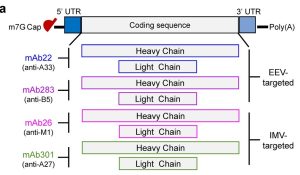The orthopoxvirus family is a lineage of pathogens that cause severe pox in humans and animals, including members such as monkeypox virus (MPXV), vaccinia virus (CPXV), and the historically notorious smallpox virus (VARV).
In the 20th century, VRAV ravaged the world, causing an estimated tragedy of about 300 million to 500 million lives, with a mortality rate of about 30%. It was not until 1980 that smallpox was finally eradicated worldwide, thanks to an unprecedented global vaccination campaign. However, to this day, orthopoxvirus infection remains a major threat to global public health.
As a DNA virus, MPXV theoretically does not mutate as frequently as RNA viruses. However, the signs of adaptive mutations observed in the genome of the recent monkeypox outbreak, combined with the context of the global outbreak of monkeypox cases, raise concerns that MPXV may have further adaptive changes that could lead to an escalation of the outbreak. Especially when the spread of MPXV originating from the Central African branch accelerates, its potential destructive power cannot be ignored. At the same time, the threat of VARV as a potential weapon of bioterrorism is always present and could make a comeback at any time. Therefore, there is an urgent need to develop effective therapeutic strategies against orthopoxvirus.
Recently, researchers from the Chinese Academy of Sciences published an article titled “Rapid development of double-hit mRNA antibody cocktail against orthopoxviruses” in the journal Signal Transduct Target Therapy, which showed that customized mRNA antibody combinations have great potential in the fight against orthopoxviruses and other emerging viruses.
The development of traditional therapeutic antibodies is constrained by the high cost of antibody engineering and manufacturing, and the development of mRNA technology in recent years has opened up a new path for antibody therapeutics. It is worth noting that mRNA-encoded antibodies against infectious agents, toxins, and even tumors have been gradually developed, and have shown better efficacy than traditional protein antibodies in preclinical and clinical trials. mRNA-encoded antibodies have emerged as an efficient, versatile, and rapidly responsive antibody generation platform.
Fig. 1 mRNAs structure of the anti-orthopoxvirus mAb.1
In this study, four mRNA panels were constructed using an established lipid nanoparticle (LNP)-encapsulated mRNA platform encoding monoclonal antibodies against orthopoxvirus with broad neutralizing activity. Experimental data showed that after a single intravenous injection of LNP-encapsulated mRNA antibodies, neutralizing antibodies were rapidly produced in mice.
More importantly, mRNA antibody treatment significantly reduced weight loss and mortality in a mouse model of lethal attack by vaccinia virus (VACV), and a unique combination, Mix2a, demonstrated superior in vivo protection by targeting both the intracellular maturation (IMV) and epimembrane (EEV) forms of the virus.
Compared to the application of only one mRNA antibody, the functional antibody levels of the Mix2a and Mix2b combinations were slightly lower. This subtle difference may be attributed to interference between different mRNA antibodies. Since mRNA-encoding antibodies are still in their early stages of development, interference between different mRNA antibodies may be one explanation for the observed differences in functional antibody levels, but the influence of other factors cannot be ruled out. In conclusion, this study successfully enables the production of orthopoxvirus antibodies using the LNP-mRNA platform, highlighting the great potential of custom mRNA antibody panels as a universal strategy against orthopoxvirus and other emerging viruses.

Fig. 2 The mRNA antibody cocktail in two batches of animals.1
In summary, for multi-component mRNA antibodies, the appropriate ratio between components is a key issue. In future experiments, it is worth exploring further to optimize the efficacy by adjusting the proportion of different mRNA antibody components. At the same time, in order to understand the potential interference mechanism, it is urgent to further study the specific process of how different mRNA antibodies interact with each other and affect their respective functions.
Reference
- Chi, Hang, et al. “Rapid development of double-hit mRNA antibody cocktail against orthopoxviruses.” Signal Transduction and Targeted Therapy1 (2024): 69.
